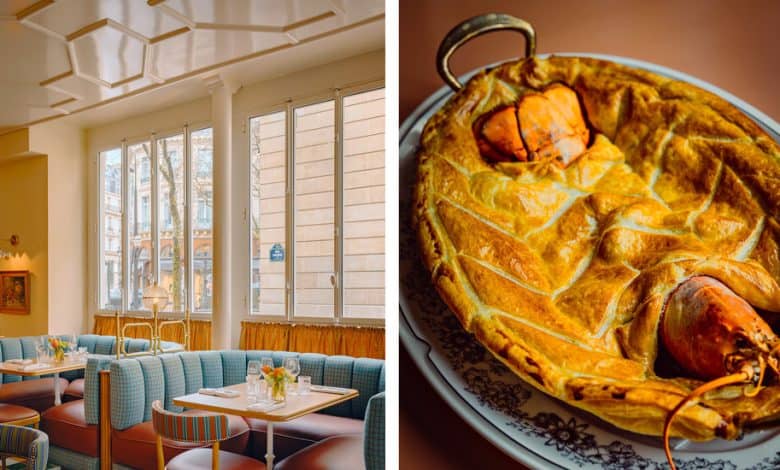Britain’s ‘Pie King’ Comes to Paris

Covet This
Folding Screens Inspired by Pompeii and Elsa Schiaparelli

Gergei Erdei’s hand-painted Peace (left) and Pompeii screens, which stand seven and a half feet tall.Credit…Wanda Martin
By Kate Maxwell
“They’re movable pieces of art,” says Budapest-born, London-based decorator Gergei Erdei of his new collection of hand-painted folding pinewood screens. Part of his Objects of Desires series, the six designs include trompe l’oeil columns, wing-footed mythological figures and interlinked geometric shapes. Erdei found inspiration for his pieces, which are over seven feet tall, in a recent retrospective of the Italian couturier Elsa Schiaparelli’s works at Paris’s Musée des Arts Décoratifs and in the lacquered screens of multimedia Art Deco creator Jean Dunand; Pompeii’s crumbling frescoes and ancient mosaics informed the mythological design’s soft, ocher hues, which were achieved through multiple coats of acrylic paint. “I keep coming back to Pompeii in my work,” Erdei says. “I find the layers faded by time so beautiful, like veils of history.”
Thought to have originated during China’s Han dynasty, screens became popular decorative pieces in Europe in the 17th century, when they were used for privacy and to divide rooms and block drafts. A couple of centuries later, Coco Chanel lined her Paris apartment with black-and-gold lacquer Coromandel screens. Erdei, who once worked as a women’s wear designer at Gucci in Rome, also wants his screens to stand out. “I see them used as a theatrical background behind a bed or a sofa, or either side of a fireplace,” he says. A bespoke screen will also make an appearance, alongside his signature acrylic murals, in his next project, the interior design of a private riad turned hotel called Le M, opening in Marrakech’s medina this summer. Objects of Desire screens from $6,700, gergeierdei.com.
Eat Here
The Chef Calum Franklin Brings His Savory Pies to Paris
By Lindsey Tramuta
English fare has rarely gotten its due in France, but the British chef Calum Franklin, nicknamed the “Pie King” from his years making artistically latticed savory pies at London’s Holborn Dining Room, is intent on changing that this month with the opening of Public House, his first project in Paris. Occupying what was previously an American bar-nightclub in the Opera district, the restaurant combines the brasserie format — broad and bustling dining rooms with deep booths — and the relaxed spirit of a British pub. Franklin wanted the menu to be an approachable mix featuring a selection of his signature pies (among them beef and bone marrow; Montgomery Cheddar, dauphinoise potato and caramelized onion; chicken and wild mushroom; and lobster for two) alongside pub classics like Scotch eggs, sausage rolls and sticky toffee pudding. “If we’re introducing Parisians to old-school British pies that are inspired by 600-year-old recipes and history, we have to do it gradually,” says Franklin. For the interiors, the architect and designer Laura Gonzalez wove in hand-finished oak furnishings, tartan fabrics that vary on each of the three floors and a patchwork of bright tiles. On the lower level, there’s a bar with its own entrance, while on the top floor, diners can sit in a spacious winter garden and play a round of darts or chess in the game room. It all makes for something fresh for Paris and an adventure for Franklin. “When I was young, a lot of my chef friends came to work in Paris but I was too shy; I didn’t speak French and it was all too easy to stay in London,” he says. “I’ve always regretted it because I saw how Paris changed them. Now, it’s my turn.” Public House opens March 26, publichouseparis.fr.
Gift This
A Cookbook — and Seder Plates — to Celebrate Passover
By Reggie Nadelson
Passover, the Jewish holiday that marks the Exodus from Egypt, is built around a meal — the Seder — and the story of the flight to the Promised Land that’s told with it. On the same night, everywhere in the world where there are Jews, the ritual meal takes place, though the food and flavors differ according to the local culture. “The Jewish Holiday Table,” a new collection of recipes curated by the Jewish Food Society, covers all the Jewish holidays and Shabbat, the Friday night Sabbath dinner. The recipes — and family histories — come from cooks with roots in Iran, India, Iraq and Israel, Morocco, Hungary, Denmark and the former Soviet Union. Many of the contributors’ families settled in New York, among them the Ethiopian-born chef Beejhy Barhany, who owns Harlem’s Tsion Café and contributed Shabbat dishes from her family village in Tigray. These include dabo, an Ethiopian honey bread, and messer wot, a red lentil stew. Fany Gerson, whose family migrated from Ukraine to Mexico City, where she was born, and who now makes doughnuts at her bakery Fan Fan in Brooklyn, spices up her Passover Seder, adding chiles and cilantro to the matzo ball soup and spicy tomato sauce to the gefilte fish. Her brisket is cooked in tamales. Serve the food you end up making on a Seder plate from Hayom, a Brooklyn-based company that collaborates with artists on Judaica. The conceptual artist Hank Willis Thomas has created a plate featuring a photograph of “Reach” (2023), his work with the artist Coby Kennedy that’s on display at Chicago’s O’Hare Airport, while the ceramist Frankie Aziz has designed one with her signature cobalt drawings.